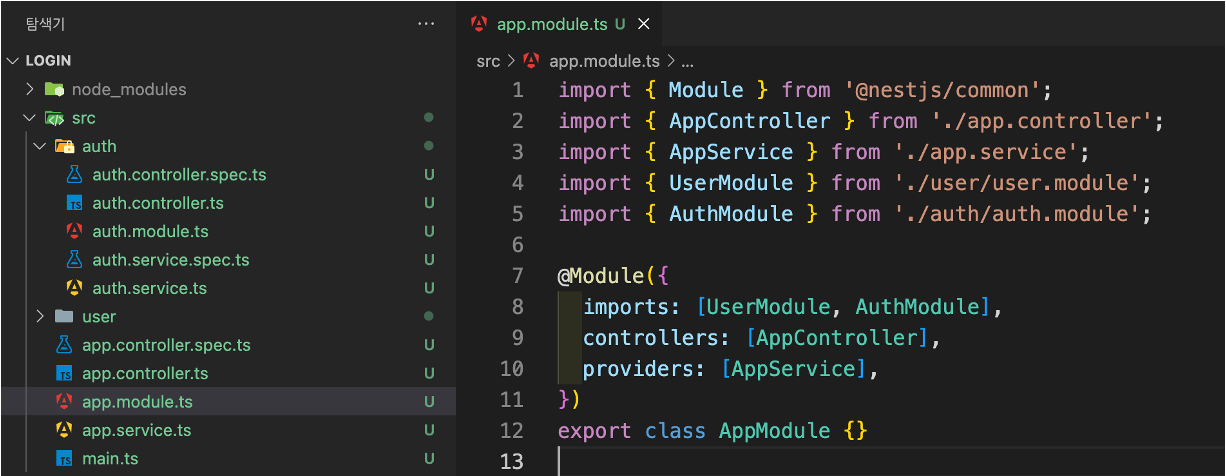Table of Contents
Setup
프로젝트 생성
pwd
----------------
/Users/peter/train/nestjs/ecommerce
nest new .
데이터베이스 생성 및 연결
CREATE DATABASE train_nestjs_ecommerce
npm install --save @nestjs/typeorm typeorm mysql2
import { Module } from '@nestjs/common';
import {TypeOrmModule} from "@nestjs/typeorm";
@Module({
imports: [
TypeOrmModule.forRoot({ // here
type: 'mysql',
database: 'train_nestjs_ecommerce',
host: 'localhost',
port: 3316,
username: 'client',
password: 'client',
autoLoadEntities: true,
synchronize: true,
})
],
controllers: [],
providers: [],
})
export class AppModule {}
// 개발용 로컬 서버를 실행했을 때, Connection Error 가 뜨지 않으면 성공
npm run start:dev
git commit -m "configuration for mysql database"
User, Auth 모듈 생성
git checkout -b login
nest g mo user
nest g co user
nest g s user
nest g mo auth
nest g co auth
nest g s auth

유저 엔티티 생성
// src/user/entities/user.entity.ts
import {Column, CreateDateColumn, Entity, PrimaryGeneratedColumn, UpdateDateColumn} from "typeorm";
import {Exclude} from "class-transformer";
@Entity('tb_user')
export class UserEntity {
@PrimaryGeneratedColumn()
id?: number;
@Column()
email: string;
@Exclude({ toPlainOnly: true }) // plain 형태로 네트워크를 통해 프론트엔드에 전달될 때는 제외되도록
@Column()
password: string;
@Column({ default: 'client' })
role?: 'admin' | 'client'
@CreateDateColumn({ name: 'created_at', type: 'datetime' })
createdAt?: Date
@UpdateDateColumn({ name: 'updated_at', type: 'datetime' })
updatedAt?: Date
}
// src/user/user.module.ts
import { Module } from '@nestjs/common';
import { UserController } from './user.controller';
import { UserService } from './user.service';
import {TypeOrmModule} from "@nestjs/typeorm";
import {UserEntity} from "./entities/user.entity";
@Module({
imports: [
TypeOrmModule.forFeature([UserEntity])
],
controllers: [UserController],
providers: [UserService],
exports: [TypeOrmModule, UserService]
})
export class UserModule {}
회원가입 로직
npm i class-validator class-transformer
// src/auth/auth.module.ts
import { Module } from '@nestjs/common';
import { AuthController } from './auth.controller';
import { AuthService } from './auth.service';
import {UserModule} from "../user/user.module";
@Module({
imports: [UserModule],
controllers: [AuthController],
providers: [AuthService]
})
export class AuthModule {}
// src/auth/dtos/auth.signup.dto.ts
import {IsEmail, IsString} from "class-validator";
export default class SignupDto {
@IsEmail()
email: string;
@IsString()
password: string;
}
// src/auth/auth.controller.ts
import {Body, Controller, Post} from '@nestjs/common';
import {AuthService} from "./auth.service";
import AuthSignupDto from "./dtos/auth.signup.dto";
@Controller('auth')
export class AuthController {
constructor(private readonly authService: AuthService) {}
@Post('signup')
async signup(@Body() signupDto: SignupDto) {
return await this.authService.signup(signupDto)
}
}
// src/auth/auth.service.ts
@Injectable()
export class AuthService {
constructor(
@InjectRepository(UserEntity) private readonly userRepo: Repository<UserEntity>,
) {}
async signup(body: UserEntity) {
const { email, password } = body;
const isEmailExists = await this.isEmailExists(email);
if (isEmailExists) {
throw new HttpException('Email already exists', HttpStatus.BAD_REQUEST);
}
const hashedPassword = await this.hashing(password)
const user = this.userRepo.create({ ...body, password: hashedPassword });
return this.userRepo.save(user); // here
}
async isEmailExists(email: string) {
return this.userRepo.existsBy({ email });
}
async hashing(plain: string) {
const saltRounds = 10;
const salt = await bcrypt.genSalt(saltRounds);
return bcrypt.hash(plain, salt);
}
}
insert()는 이미 존재하는지 조회하지 않고 바로 레코드를 생성하지만, 반환되는 값이 레코드가 아닌 메타데이터이다save()는 이미 존재하면 업데이트 하는 로직을 포함해 성능상 단점이 있지만, 반환되는 값이 레코드이기 때문에 깔끔하다- 그래서 일단은 레코드를 반환하는게 코드가 명확하다고 생각해
save()메서드를 사용했다. 만약 성능상 개선이 필요하다면insert()를 사용해도 괜찮을 것 같다
Login
- 이메일, 비밀번호 기반의 로그인의 경우, 이메일이 존재하는지 먼저 확인하고, 존재하면 이메일로 유저를 찾아 해당 유저의 비밀번호가 일치하는지 확인한다
- 유저의 이메일과 비밀번호가 알맞은 경우, 로그인 상태를 유지하기 위해, jwt 토큰을 쿠키로 저장해둔다
npm install --save @nestjs/jwt
import {HttpException, HttpStatus, Injectable} from '@nestjs/common';
import {InjectRepository} from "@nestjs/typeorm";
import {UserEntity} from "../user/entities/user.entity";
import {Repository} from "typeorm";
import * as bcrypt from 'bcrypt';
import {JwtService} from "@nestjs/jwt";
@Injectable()
export class AuthService {
constructor(
@InjectRepository(UserEntity) private readonly userRepo: Repository<UserEntity>,
private readonly jwtService: JwtService,
) {}
async getVerifiedUser(email: string, password: string) {
const user = await this.userRepo.findOneBy({ email })
if (user) {
const isVerified = await bcrypt.compare(password, user.password);
if (isVerified) {
return user;
}
}
throw new HttpException('Email or password is wrong', HttpStatus.UNAUTHORIZED);
}
getToken(user: UserEntity) {
const payload = { sub: user.id, email: user.email }
const accessToken = this.jwtService.sign(payload, { expiresIn: '15m' })
const refreshToken = this.jwtService.sign(payload, { expiresIn: '7d' })
return { accessToken, refreshToken };
}
async login(email: string, password: string) {
const user = await this.getVerifiedUser(email, password);
return this.getToken(user)
}
}
Authentication
- 이제 로그인에 성공했으므로, 로그인 여부를 확인해야 하는 경우에 대해 살펴보자
- 대부분의 서비스에는 로그인 여부를 확인해야 하는 라우트가 있다 (ex. 결제, 글 올리기 등)
- 로그인 여부를 확인하는 방법은, 쿠키의 jwt 토큰 값을 확인하는 것이다
- 클라이언트는 jwt 토큰을
Cookies헤더 또는Authorization헤더에 포함시키면 된다 - jwt가 없거나, 유효하지 않은 경우 로그인이 필요한 상황이라 간주한다
- 유효한 jwt를 가진 경우 로그인 됐다고 간주한다
- 쿠키 값을 읽으려면
cookie-parser를 설치해야 한다
npm i cookie-parser
npm i -D @types/cookie-parser
Guard
- Authentication 이 필요한 라우트마다, 쿠키에 저장된 jwt 값을 읽고, 검증하는 과정을 반복하는 것은 좋지 않다
- NestJS에서는
Guard라는 인증/인가를 위한 용도의 클래스를 제공한다 - NestJS의 Guard 클래스 안에 이러한 로직을 작성해주면, Guard가 라우트 안의 코드가 실행되기 전에 먼저 Authentication 을 한다
// src/auth/guards/auth.jwt.guard.ts
import {
CanActivate,
ExecutionContext,
Injectable,
} from '@nestjs/common'
import { Request, Response } from 'express'
import {AuthService} from "../auth.service";
@Injectable()
export default class JwtGuard implements CanActivate {
constructor(private readonly authService: AuthService) {}
async canActivate(context: ExecutionContext): Promise<boolean> {
const request: Request = context.switchToHttp().getRequest()
const response: Response = context.switchToHttp().getResponse()
const accessToken = request?.cookies?.accessToken
const user = await this.authService.getVerifiedUserByJwt(accessToken)
if (user) {
console.log('액세스 토큰 있음')
request['user'] = user
return true
} else {
const refreshToken = request?.cookies?.refreshToken
const user = await this.authService.getVerifiedUserByJwt(refreshToken)
if (user) {
console.log('액세스 토큰 만료됨. 리프레쉬 토큰으로 액세스 토큰 재발급')
const { accessToken } = this.authService.getToken(user)
response.cookie('accessToken', accessToken)
request['user'] = user
return true
} else {
console.log('리프레쉬 토큰 만료. 로그인 필요')
return false
}
}
}
}
jwtService.verify(token)는 토큰이 유효하면payload, 유효하지 않거나 만료된 토큰이면 500 에러가 발생한다- 이를 try-catch 문으로 적절하게 처리해줘야 한다
// src/auth/auth.service.ts
import {HttpException, HttpStatus, Injectable} from '@nestjs/common';
import {InjectRepository} from "@nestjs/typeorm";
import {UserEntity} from "../user/entities/user.entity";
import {Repository} from "typeorm";
import {JwtService} from "@nestjs/jwt";
@Injectable()
export class AuthService {
constructor(
@InjectRepository(UserEntity) private readonly userRepo: Repository<UserEntity>,
private readonly jwtService: JwtService,
) {}
async getVerifiedUserByJwt(token: string) {
try {
const payload = this.jwtService.verify<JwtPayload>(token);
return await this.userRepo.findOneBy({ id: payload.sub });
} catch (error) {
if (error.name === 'TokenExpiredError' || error.name === 'JsonWebTokenError') {
return null
} else {
throw new HttpException('An error occurred while verifying the token', HttpStatus.INTERNAL_SERVER_ERROR);
}
}
}
}
// src/auth/auth.controller.ts
import {Body, Controller, Get, Post, Req, Res, UseGuards} from '@nestjs/common';
import {AuthService} from "./auth.service";
import AuthSignupDto from "./dtos/auth.signup.dto";
import { Response } from 'express';
import JwtGuard from "./guards/auth.jwt.guard";
@Controller('auth')
export class AuthController {
constructor(
private readonly authService: AuthService) {}
@UseGuards(JwtGuard)
@Get('test')
async authTest(@Req() req: Request) {
return req['user']
}
}
- JwtGuard 는 AuthService 를 주입받고 있다. 그래서 JwtGuard 를 쓰려면 사용하는 곳에서 AuthModule 을 임포트 해야 한다
- JwtGuard 는 여러 곳에서 사용되기 때문에, AuthModule 은 글로벌 모듈로 만들어도 좋다
// src/auth/auth.module.ts
import {Global, Module} from '@nestjs/common';
import { AuthController } from './auth.controller';
import { AuthService } from './auth.service';
import {UserModule} from "../user/user.module";
import {JwtModule} from "@nestjs/jwt";
@Global()
@Module({
imports: [
JwtModule.register({
secret: 'tHIsISsECret'
}),
UserModule
],
controllers: [AuthController],
providers: [AuthService],
exports: [AuthService],
})
export class AuthModule {}
Passport
- Passport 라이브러리는 node.js 인증 라이브러리 중 하나로 많은 운영 단계의 애플리케이션들에서 성공적으로 사용되고 있다
- 위에서 유저의 유효성을 검증하고, 요청(request) 객체의 속성에 유저 정보를 추가하는 과정을 표준 패턴으로 추상화하여 제공해준다
- 여러 인증 메커니즘을 공통된 패턴으로 구현하도록 도와준다
- (Google, Amazon, Kakao 같은 여러 기업의 계정 정보를 이용해 인증을 진행할 수도 있다) 참고
npm install @nestjs/passport passport
- 여기서는 가장 기본적인 인증 메커니즘인, local 방식과, jwt 방식을 알아본다
Local Strategy
- local strategy는 사실상 username, password로 로그인을 구현하는 것과 같다
npm install passport-local
npm install -D @types/passport-local
JWT Strategy
npm install passport-jwt
npm install -D @types/passport-jwt



































![[NestJS] 로그인](/images/nestjs_practice_logo.png)
